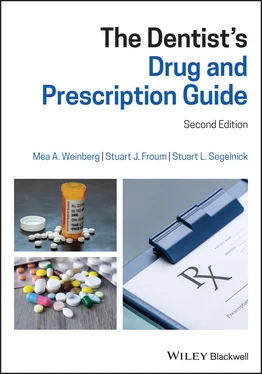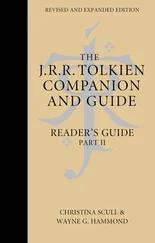1 ...8 9 10 12 13 14 ...20 59 Q. How do I write for a prescription for doxycycline?
60 A. See Figure 2.1.Interpretation of prescription: the salt form of doxycycline is hyclate or monohydrate. Doxycycline monohydrate is used in the treatment of acne. Doxycycline hyclate is used for other bacterial infections. So it is necessary to identify the correct salt form. Also, in order to write a prescription, it must be known whether to write for capsules or tablets. Doxycycline is supplied as 50, 75, and 100 mg capsules or tablets. In this prescription, the prescriber prescribed capsules. Latin abbreviations were used but they were written legibly. It is probably safest not to use Latin abbreviations but rather write the prescription in English. The number of days the patient should take the medication for was indicated (× 10 days; the × refers to “for”). Also, it is important for the safety of the patient to write on the prescription “for dental infections” because the patient may be taking many different medications and may have a lot of pill containers in the medicine cabinet. Identifying this prescription bottle for use for a dental infection will make it easier for the patient to pick up that container. Directions for use (Sig:): Take one capsule orally every 12 hours on day 1, then one capsule every day for 10 days for dental infections.
2.5 How to Avoid Prescription Errors
1 Q. How can I prevent medication errors when writing a prescription?
2 A. If your handwriting is poor, consider faxing or e‐prescribing. Also, many drug names are very similar. To avoid misinterpretation, names should be written clearly and the use of abbreviations should be avoided. Also, before sending, review the prescription and make sure the drug, strength, and directions are correct.
3 Q. What else can I do to avoid prescribing errors?
4 A. Always interview your patient thoroughly about allergies. For example, a patient with asthma who is allergic to aspirin may experience an acute bronchospasm after taking an NSAID such as ibuprofen (Advil, Nuprin®) or naproxen sodium (Aleve). In adults, this reaction is called Samter's triad and it is a condition consisting of asthma, nonallergic aspirin sensitivity, and nasal polyps. Recently, a fourth symptom has been added, hyperplastic sinusitis, and instead of Samter's triad, it can also be called aspirin‐exacerbated respiratory disease. This occurs because NSAIDs block the production of prostaglandins and leukotrienes, which are chemical substances involved in the inflammatory response resulting in severe allergy‐like symptoms. It is best to avoid aspirin and NSAIDs in asthmatics. Figure 2.1 How a prescription for doxycycline is written.Another example: clindamycin is prescribed to a patient who is allergic to penicillin. A review of the patient's history confirms she has a history of ulcerative colitis. Clindamycin is contraindicated in an individual with a history of ulcerative colitis. An alternative would be azithromycin (Zithromax®). Refer to Chapter 4.
5 Q. Can there be errors when writing decimal points and zeros on a prescription?
6 A. Yes. To avoid prescription misinterpretations, avoid unnecessary decimal points. For example, when writing for 5 mL of a suspension or solution, it should be written as 5 mL not 5.0 mL because the 5.0 could be understood as 50. Also, always place a zero before quantities. For example, write 0.25 mg and not .25 mg because this could be misinterpreted as 25 mg.
7 Q. Should I review the prescription with the patient?
8 A. Definitely. The dentist should go over the medication and how to take it, including the number, frequency, and with meals or on an empty stomach. Also, make sure the patient is not allergic to the medication. Don't just review the medical history in the chart. You must ask the patient if he/she is allergic. If the patient confirms allergy, ask what happened when that drug was taken. Ask if there was a rash or difficulty breathing or just gastrointestinal upset (diarrhea). Document in the chart that you reviewed how to take the medication with the patient, whether history of allergies was denied, and if the patient had or did not have any questions and that they understood everything.
9 Q. Is it OK to use the Latin abbreviations on how to take the medicine?
10 A. Yes, but it is not advised because misinterpretation of abbreviations is a common source of error. Overdoses have occurred when “qd” used for every day was interpreted as “qid,” four times a day. It is recommended not to abbreviate and to write out all instructions in English and avoid Latin abbreviations.
11 Q. Is it acceptable to write abbreviations of drugs?
12 A. No. The full name should be written legibly. For instance, do not write PCN for penicillin V.
13 Q. Is it acceptable to write “take as directed”?
14 A. No. The instruction “take as directed” or “take as needed” is not satisfactory and should be avoided. Patients may fail to understand or forget the instructions given in the prescriber's office. Similarly, most insurance companies will only reimburse the patient or pharmacist for a specific number of doses or duration of treatment. The same thing holds true with writing “as needed.” The directions to the patient should include a reminder of the intended purpose of the medication by including such phrases as “for relief of dental pain” or “for dental infection” (Warner and Mitchell 2008).
15 Q. What about recommending over‐the‐counter drugs?
16 A. Even though OTC drugs are not prescription or legend drugs, if the dentist recommends an OTC in the dental office the same responsibilities for proper prescribing apply. For example, after a surgical procedure the patient asks which OTC analgesic is good to take. Do not recommend any OTC drug without reviewing the medical history. If the patient has controlled hypertension and is taking a beta‐blocker, NSAIDs (e.g., ibuprofen, naproxen sodium) in doses adequate to reduce inflammation and pain can increase blood pressure in both normotensive and hypertensive individuals. In addition, NSAID use may reduce the effect of all antihypertensive drugs except calcium channel blockers (nifedipine [Procardia®], amlodipine [Norvac®]). The manufacturer recommends that NSAIDs be used for a maximum of five days in patients taking any antihypertensive drugs except for calcium channel blockers (White 2007).
17 Q. Is there any special labeling of OTC drugs?
18 A. Yes. In the Federal Register of March 1999, the FDA published the OTC Drug Facts Label regulation. This regulation required most OTC drug products to comply with the new format and content requirements by May 2002. This “new” drug labeling of OTC was intended to inform the consumer about the medication in an easy‐to‐read label. OTC medicines also differ from prescription drugs in their labeling. The OTC Drug Facts label contains all the information a consumer needs in order to select an appropriate OTC medicine, to use the medicine safely and effectively, and to decide when to consult a physician, if needed. Some changes to the labeling include the word “uses” which replaces “indications,” and terms such as “precautions” and “contraindications” have been replaced with more easily understood words. The label is written in large font and formatted with bullet points, so it is easier to read.
1 Balthasar, J. (1999). Bioequivalence and bioequivalency testing. American Journal of Pharmaceutical Education 63: 194–198.
2 Birkett, D. (2003). Generics – equal or not? Australian Prescriber 26: 85–87.
3 Food and Drug Administration (2008). Approved Drug Products with Therapeutic Equivalence Evaluations. www.fda.gov/drugs/resources‐information‐approved‐drugs/approved‐drug‐ products‐therapeutic‐equivalence‐evaluations‐orange‐book.
Читать дальше












